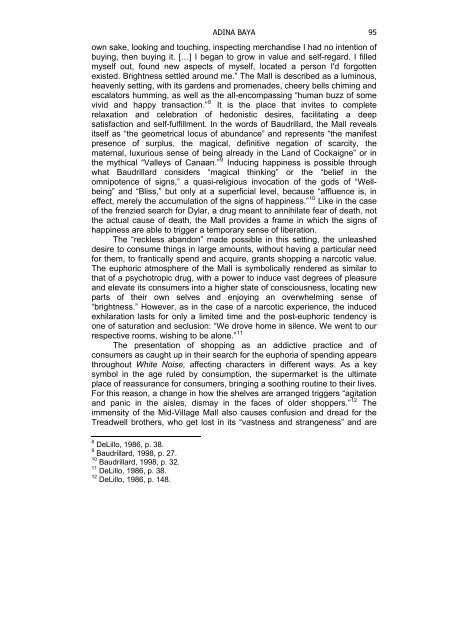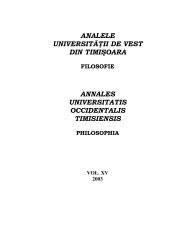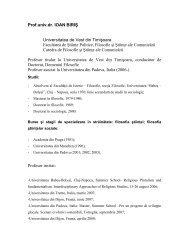VOL. IV (XXI) 2009 - Departamentul de Filosofie si Stiinte ale ...
VOL. IV (XXI) 2009 - Departamentul de Filosofie si Stiinte ale ...
VOL. IV (XXI) 2009 - Departamentul de Filosofie si Stiinte ale ...
You also want an ePaper? Increase the reach of your titles
YUMPU automatically turns print PDFs into web optimized ePapers that Google loves.
ADINA BAYA 95<br />
own sake, looking and touching, inspecting merchandise I had no intention of<br />
buying, then buying it. […] I began to grow in value and self-regard. I filled<br />
myself out, found new aspects of myself, located a person I'd forgotten<br />
existed. Brightness settled around me.” The Mall is <strong>de</strong>scribed as a luminous,<br />
heavenly setting, with its gar<strong>de</strong>ns and promena<strong>de</strong>s, cheery bells chiming and<br />
escalators humming, as well as the all-encompas<strong>si</strong>ng “human buzz of some<br />
vivid and happy transaction.” 8 It is the place that invites to complete<br />
relaxation and celebration of hedonistic <strong>de</strong><strong>si</strong>res, facilitating a <strong>de</strong>ep<br />
satisfaction and self-fulfillment. In the words of Baudrillard, the Mall reveals<br />
itself as “the geometrical locus of abundance” and represents “the manifest<br />
presence of surplus, the magical, <strong>de</strong>finitive negation of scarcity, the<br />
maternal, luxurious sense of being already in the Land of Cockaigne” or in<br />
the mythical “Valleys of Canaan.” 9 Inducing happiness is pos<strong>si</strong>ble through<br />
what Baudrillard con<strong>si</strong><strong>de</strong>rs “magical thinking” or the “belief in the<br />
omnipotence of <strong>si</strong>gns,” a qua<strong>si</strong>-religious invocation of the gods of “Wellbeing”<br />
and “Bliss,” but only at a superficial level, because “affluence is, in<br />
effect, merely the accumulation of the <strong>si</strong>gns of happiness.” 10 Like in the case<br />
of the frenzied search for Dylar, a drug meant to annihilate fear of <strong>de</strong>ath, not<br />
the actual cause of <strong>de</strong>ath, the Mall provi<strong>de</strong>s a frame in which the <strong>si</strong>gns of<br />
happiness are able to trigger a temporary sense of liberation.<br />
The “reckless abandon” ma<strong>de</strong> pos<strong>si</strong>ble in this setting, the unleashed<br />
<strong>de</strong><strong>si</strong>re to consume things in large amounts, without having a particular need<br />
for them, to frantically spend and acquire, grants shopping a narcotic value.<br />
The euphoric atmosphere of the Mall is symbolically ren<strong>de</strong>red as <strong>si</strong>milar to<br />
that of a psychotropic drug, with a power to induce vast <strong>de</strong>grees of pleasure<br />
and elevate its consumers into a higher state of consciousness, locating new<br />
parts of their own selves and enjoying an overwhelming sense of<br />
“brightness.” However, as in the case of a narcotic experience, the induced<br />
exhilaration lasts for only a limited time and the post-euphoric ten<strong>de</strong>ncy is<br />
one of saturation and seclu<strong>si</strong>on: “We drove home in <strong>si</strong>lence. We went to our<br />
respective rooms, wishing to be alone.” 11<br />
The presentation of shopping as an addictive practice and of<br />
consumers as caught up in their search for the euphoria of spending appears<br />
throughout White Noise, affecting characters in different ways. As a key<br />
symbol in the age ruled by consumption, the supermarket is the ultimate<br />
place of reassurance for consumers, bringing a soothing routine to their lives.<br />
For this reason, a change in how the shelves are arranged triggers “agitation<br />
and panic in the aisles, dismay in the faces of ol<strong>de</strong>r shoppers.” 12 The<br />
immen<strong>si</strong>ty of the Mid-Village Mall also causes confu<strong>si</strong>on and dread for the<br />
Treadwell brothers, who get lost in its “vastness and strangeness” and are<br />
8 DeLillo, 1986, p. 38.<br />
9 Baudrillard, 1998, p. 27.<br />
10 Baudrillard, 1998, p. 32.<br />
11 DeLillo, 1986, p. 38.<br />
12 DeLillo, 1986, p. 148.




